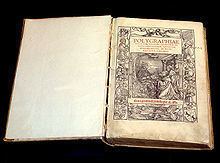Original title Polygraphia Language Latin Published in English N/A Originally published 1518 | Country Germany Publication date 1518 Media type Printed book | |
 | ||
Genres Cryptography, Steganography Similar The Sworn Book of Honorius, Mercury or The Secret and Swift, Three Books of Occult Ph, The Magus, Oedipus Aegyptiacus | ||
Polygraphia is a cryptographic work written by Johannes Trithemius published in 1518 dedicated to the art of steganography.
Contents
Review
It is composed of five books, the work consists of five books and a collarbone
The work ends with alphabets of his invention as the "tetragramaticus" formed by 4 characters that are diversified in 24 letters and the "enagramaticus" of 9 characters and 28 letters, from which he gives examples of writings that belongs to something it resembles a natural language.
Relationship with steganography
According to some scholars, both books, Steganographia and Polygraphia are but a single work presented in two parts: the first is metaphysical and quite theoretical (arriving to hide a full treaty "angelology," or study of angels with their names and hierarchies, between its pages), the second is more practical and is used for encoding messages.
